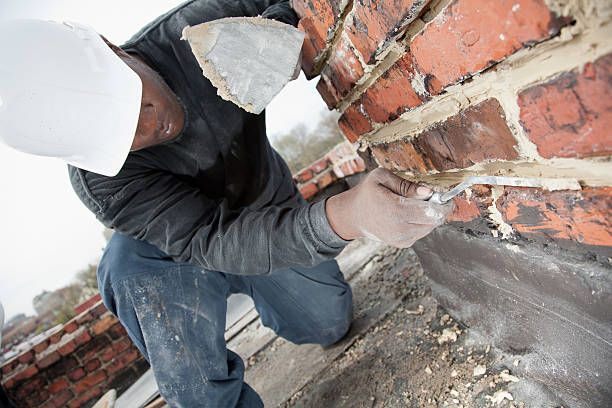Chimney Flashing and Cap Repair: Secure Your Home from Aspects
Chimney Flashing and Cap Repair: Secure Your Home from Aspects
Blog Article
Opening the Keys of Sustainable Masonry Building Practices for Eco-Friendly Buildings
Among the myriad methods to eco-friendly building, sustainable stonework construction stands out as a time-tested and durable approach that holds a wide range of untapped capacity. From the option of materials to cutting-edge building methods, the secrets to achieving sustainability within masonry building are multifaceted and appealing.
Benefits of Sustainable Stonework Construction
Embracing sustainable stonework building and construction techniques not just decreases environmental impact yet likewise provides long-term financial advantages to building contractors and neighborhoods. By using materials like recycled blocks, obstructs, and stones, builders can dramatically lower the carbon footprint of their tasks while advertising resource performance. Furthermore, sustainable stonework building techniques, such as correct insulation and thermal mass residential or commercial properties, can improve power effectiveness within buildings, bring about minimized operational prices in time.
In addition, the longevity and durability of stonework structures add to long-lasting economic benefits. Structures built using lasting masonry methods frequently call for less upkeep and repair work, equating to cost financial savings for home builders and homeowner. The durability of stonework materials likewise ensures that structures continue to be stable and safe, reducing the requirement for constant remodellings or substitutes.
Eco-Friendly Stonework Materials
Using green stonework products is a pivotal step in the direction of enhancing the sustainability of building and construction practices and reducing ecological influence while optimizing lasting financial benefits. Sustainable masonry products are sourced, generated, and utilized in a manner that minimizes total environmental effect. Products such as recycled bricks, recovered rock, and lasting cinder block are becoming increasingly preferred options for eco-conscious home builders. Recycled bricks, as an example, not only divert waste from landfills but additionally require less power to generate compared to brand-new blocks. Reclaimed stone uses an one-of-a-kind aesthetic allure while decreasing the demand for new quarrying. Lasting concrete obstructs include recycled accumulations and may include improved insulation homes, adding to power effectiveness in structures.
Moreover, natural products like adobe, rammed planet, and straw bales give superb thermal mass buildings, minimizing the requirement for heating and cooling down energy. These products are commonly locally available, advertising local economic climates and decreasing transportation-related carbon emissions. By selecting eco-friendly stonework materials, building jobs can substantially lower their environmental footprint and contribute to the development of much healthier, extra sustainable constructed environments.
Energy-Efficient Stonework Techniques
Power effectiveness plays a vital function in enhancing the sustainability of stonework building practices. By applying energy-efficient masonry strategies, home builders can considerably lower the overall power usage of a structure, resulting in lower operational prices and a smaller ecological footprint. One vital energy-efficient masonry technique is the usage of thermal mass, which involves including dense materials like concrete or brick into the building's structure to absorb and store warm. This assists control interior temperature levels, reducing the need for mechanical heating and cooling systems.

Advancements in Lasting Stonework
Recent innovations in lasting masonry techniques have caused innovative strategies that are improving the building market. One such innovation is the development of self-healing concrete, which makes use of bacteria embedded within the concrete to recover cracks autonomously. This development not just reduces maintenance costs yet also improves the resilience of stonework frameworks, contributing to their sustainability.
One more remarkable have a peek at this site innovation is using recycled accumulations in stonework construction - masonry contractor. By incorporating materials such as smashed ceramic waste or recycled glass right into concrete blends, contractors can minimize the ecological effect of building tasks while keeping architectural integrity. This practice not only diverts waste from garbage dumps but additionally preserves natural deposits, making it a key development in sustainable masonry building
Additionally, the integration of electronic layout devices, such as Structure Details Modeling (BIM), is changing the means stonework frameworks are intended and created. BIM permits for even more exact computations, minimized product wastefulness, and boosted power performance, inevitably bring about even more sustainable building practices. These innovations jointly indicate an encouraging future for lasting stonework building and construction in the age of environmentally friendly buildings.
Future Trends in Masonry Sustainability
With the innovative strides made in lasting stonework methods, the future patterns in masonry sustainability are poised to additional transform the construction market. One of the key trends shaping the future of masonry sustainability is the increased assimilation of modern technology. Innovations such as Structure Info Modeling (BIM) and online truth simulations are being utilized to enhance stonework building and construction processes, leading to lowered material waste and improved power efficiency in structures.
Moreover, the development of unique sustainable products is readied to play a significant role in boosting the eco-friendliness of masonry building. masonry contractor. Developments prefabricated concrete like self-healing concrete, recycled accumulations, and bio-based binders are acquiring grip for their ability to decrease environmental influence while maintaining architectural integrity

Conclusion
In final thought, sustainable masonry construction practices provide various benefits for environmentally friendly buildings. masonry contractor. Developments in sustainable stonework are continually being established to even more improve the environmental efficiency of buildings.
Report this page